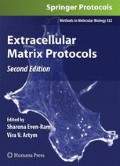Summary
Fibronectin fibrillogenesis is a cell-mediated, step-wise process that converts soluble fibronectin into insoluble fibronectin matrix. The deposition of fibronectin fibrils occurs at specific sites on the cell surface and depends on the unfolding of the fibronectin dimer. Fibronectin matrix provides positional information for cell migration during early embryogenesis and plays an important role in cell growth, differentiation, survival, and oncogenic transformation. Here we present simple techniques, based on the use of fluorescently labeled fibronectin and species-specific antifibronectin antibodies that allow determination of the fibronectin fibril growth in conventional in vitro cell cultures and in three-dimensional matrix environment.
Access this chapter
Tax calculation will be finalised at checkout
Purchases are for personal use only
References
Dallas SL, Chen Q, Sivakumar P.(2006) Dynamics of assembly and reorganization of extracellular matrix proteins.Curr Top Dev Biol;75:1–24
Trelstad RL. (1984) The Role of Extracellular Matrix in Development.New York: Alan R. Liss
Larsen M, Artym VV, Green JA, Yamada KM.(2006) The matrix reorganized: extracellular matrix remodeling and integrin signaling.Curr Opin Cell Biol;5:463–471
Hay, E.D. Editor.(1991) Cell Biology of Extracellular Matrix, 2nd edn.New York: Plenum Press
Piez KA, Reddi HA. (1984) Extracellular Matrix Biochemistry.New York: Elsevier
George EL, Georges-Labouesse EN, Patel-King RS, Rayburn H, Hynes RO.(1993) Defects in mesoderm, neural tube and vascular development in mouse embryos lacking fibronectin.Development;119:1079–1091
Williams EC, Janmey PA, Ferry JD, Mosher DF.(1982) Conformational states of fibronectin. Effects of pH, ionic strength, and collagen binding.J Biol Chem;257:14973–14978
Geiger B, Bershadsky A, Pankov R, Yamada KM.(2001) Transmembrane crosstalk between the extracellular matrix–cytoskeleton crosstalk.Nat Rev Mol Cell Biol;2:793–805
Pankov R, Yamada KM.(2002) Fibronectin at a glance.J Cell Sci;115:3861–3863
Pankov R, Cukierman E, Katz BZ, Matsumoto K, Lin DC, Lin S, Hahn C, KM. Yamada (2000) Integrin dynamics and matrix assembly: tensin-dependent translocation of alpha (5)beta(1) integrins promotes early fibronectin fibrillogenesis.J Cell Biol;148:1075–1090
Cukierman E, Pankov R, Stevens DR, Yamada KM.(2001) Taking cell-matrix adhesions to the third dimension.Science;294:1708–1712
Cukierman E, Pankov R, Yamada KM.(2002) Cell interactions with three-dimensional matrices.Curr Opin Cell Biol;14:633–639
Mould AP, Garratt AN, Askari JA, Akyiama SK, Humphries MJ.(1995) Identification of a novel anti-integrin monoclonal antibody that recognizes a ligand-induced binding site epitope on the beta 1subunit.FEBS Lett;363:118–122
Cukierman E. Preparation of extracellular matrices produced by cultured fibroblasts. In: Dasso BM, Lippincott-Schwartz J, Yamada KM (eds.), Current Protocols in Cell Biology, vol 2. New York: Wiley, pp. 10.9.1–10.9.14
Acknowledgments
Part of this work was supported by the Bulgarian National Fund for Scientific Research (Grant By-Б-1/05 and 1404/04).
Author information
Authors and Affiliations
Corresponding author
Editor information
Editors and Affiliations
Rights and permissions
Copyright information
© 2009 Humana Press, a part of Springer Science+Business Media, LLC
About this protocol
Cite this protocol
Pankov, R., Momchilova, A. (2009). Fluorescent Labeling Techniques for Investigation of Fibronectin Fibrillogenesis (Labeling Fibronectin Fibrillogenesis). In: Even-Ram, S., Artym, V. (eds) Extracellular Matrix Protocols. Methods in Molecular Biology, vol 522. Humana Press. https://doi.org/10.1007/978-1-59745-413-1_18
Download citation
DOI: https://doi.org/10.1007/978-1-59745-413-1_18
Published:
Publisher Name: Humana Press
Print ISBN: 978-1-58829-984-0
Online ISBN: 978-1-59745-413-1
eBook Packages: Springer Protocols

